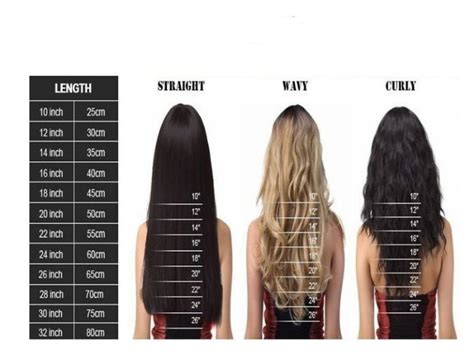Measuring hair length is crucial for monitoring growth, determining styling options, and communicating with hair professionals. Whether you’re considering a trim, a transformative haircut, or simply curious about the progress of your locks, this comprehensive hair inch chart will guide you.

Inches, Centimeters, and Beyond
The most common unit of hair length measurement is inches (in), followed by centimeters (cm). One inch equals approximately 2.54 centimeters. For those who prefer metric measurements, our chart provides both inch and centimeter measurements for easy conversion.
Measuring Techniques
To accurately measure your hair length, follow these steps:
- Choose the right position: Stand upright with your head held level.
- Dampen your hair: Wet or slightly damp hair is easier to measure.
- Use a measuring tape or ruler: Place one end at the base of your scalp and extend it down to the desired point.
- Pull taut: Gently pull the tape or ruler taut without stretching the hair.
- Record the measurement: Note the measurement in inches or centimeters.
Hair Inch Chart
| Length | Inches | Centimeters |
|---|---|---|
| Pixie cut | 1-3 | 2.5-7.6 |
| Short bob | 4-6 | 10.2-15.2 |
| Medium bob | 7-9 | 17.8-22.9 |
| Long bob (lob) | 10-12 | 25.4-30.5 |
| Shoulder-length | 13-15 | 33-38.1 |
| Mid-back | 16-18 | 40.6-45.7 |
| Waist-length | 19-21 | 48.3-53.3 |
| Hip-length | 22-24 | 55.9-61 |
| Classic length | 25-27 | 63.5-68.6 |
| Extra-long | 28-30 | 71.1-76.2 |
| Terminal length | 30+ | 76.2+ |
Growth Rates
On average, hair grows about 0.5 inches per month. However, this rate can vary based on genetics, age, diet, and overall health.
Factors Affecting Hair Growth
- Genetics: Your genes play a significant role in determining your hair’s growth rate, thickness, and texture.
- Age: Hair growth tends to slow down with age.
- Diet: A healthy diet rich in protein, biotin, and other hair-boosting nutrients can support hair growth.
- Hormonal imbalances: Certain hormonal changes, such as during pregnancy or menopause, can impact hair growth.
- Medications: Some medications, such as chemotherapy and birth control, can cause hair loss or thinning.
Hair Length Milestones
- 6 months: Hair typically grows about 3 inches, allowing for minor trims or subtle changes.
- 1 year: Hair can reach between 6 and 7 inches, providing options for medium-length styles.
- 2 years: Hair may grow to 12-14 inches, enabling more versatile styling options, such as long bobs and layers.
- 3 years: Hair can reach 18-21 inches, opening up possibilities for waist-length or longer tresses.
Styling Considerations
Your hair length can influence the styles you choose:
- Short hair: Pixie cuts, short bobs, and other short styles are ideal for those who want low-maintenance options.
- Medium hair: Medium bobs, lobs, and shoulder-length hair offer versatility for styling, from bouncy curls to sleek blowouts.
- Long hair: Waist-length or longer hair allows for intricate braids, elegant updos, and voluminous styles.
Hair Extensions
For those who desire longer hair quickly, hair extensions can be a solution. Extensions range from clip-ins to permanent fusion methods.
Hair Care Tips
- Wash and condition regularly: Regular washing and conditioning keeps hair healthy and promotes growth.
- Use heat protectants: Heat styling tools can damage hair. Always apply a heat protectant before using hot tools.
- Trim split ends: Trimming split ends prevents further damage and keeps hair looking healthy.
- Get regular trims: Regular trims remove dead or damaged hair, allowing new growth to thrive.
- Avoid harsh chemicals: Harsh chemicals in hair dyes and relaxers can damage the structure of the hair.
FAQs
- How often should I measure my hair length? Every 3-6 months to track progress and determine if a trim is necessary.
- Can stress affect hair growth? Yes, chronic stress can lead to hair loss or thinning.
- What is the average hair length for women? About 18 inches, but it varies widely across individuals.
- What is the “terminal length” of hair? The maximum length your hair can grow before entering the resting phase.
- Can hair extensions damage my natural hair? Improper installation or care can lead to damage. Consult a professional hairstylist for guidance.
- How can I promote hair growth? A healthy diet, adequate sleep, and regular exercise support hair growth.
- Should I trim my split ends regularly? Yes, every 6-8 weeks to prevent further damage.
- Is it better to cut hair wet or dry? Dry, as hair tends to shrink when wet, which can lead to shorter-than-desired results.
